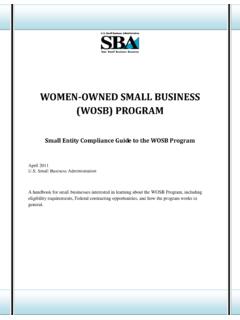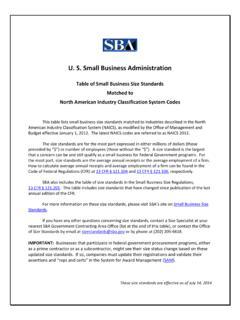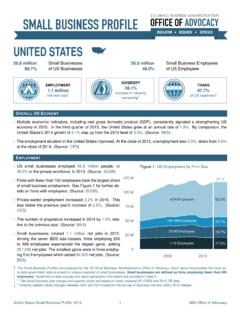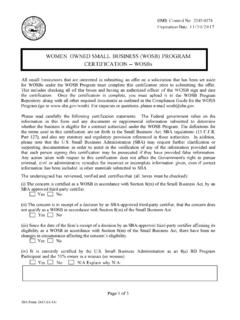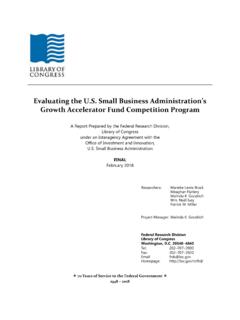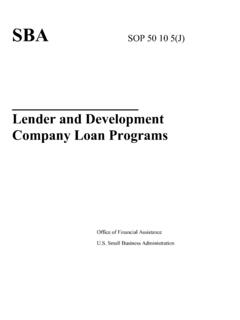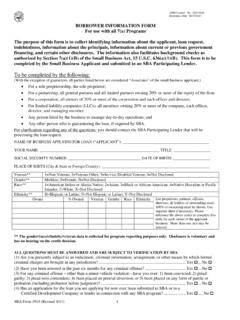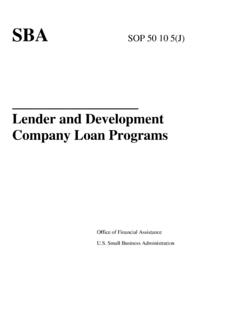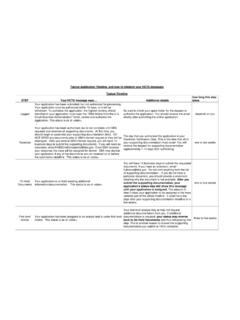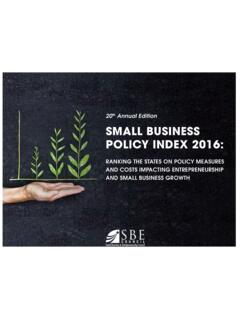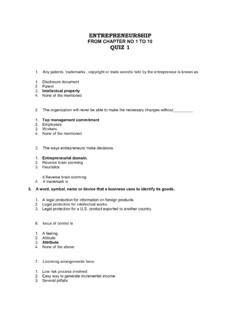Transcription of The Dynamic Relationship between Entrepreneurship ...
1 The Dynamic Relationship between Entrepreneurship , unemployment , and Growth: Evidence from Industries by Jose M. Plehn-Dujowich Plehn Analytical Economic Solutions, LLC Willow Grove, PA 19090 for under contract number SBAHQ-10-M-0204 The statements, findings, conclusions, and recommendations found in this study are those of the authors and do not necessarily reflect the views of the Office of Advocacy, the United States small business administration , or the United States of Contents Executive Summary .. 3 1. Introduction .. 3 2. Literature Review .. 5 Empirical Studies Relating Growth and Entrepreneurship .. 5 Self-Employment as Entrepreneurship .. 5 New business Startups as Entrepreneurship .. 6 The Global Entrepreneurship Monitor (GEM) and World Bank Group Entrepreneurship Survey (WBGES) .. 7 Empirical Studies Relating Growth and unemployment .. 8 Theories of Entrepreneurship .. 9 3. Data Sources .. 9 Measure of Entrepreneurship .
2 9 Measure of 10 Measure of Growth .. 11 Merging the Datasets .. 12 4. Econometric Techniques .. 12 Estimation of Dynamic Panel Models .. 13 Estimation under Cross-Sectional Dependence .. 15 5. Empirical Results .. 18 Descriptive Statistics .. 18 Empirical Results .. 18 What Granger-Causes Entrepreneurship ? .. 19 What Granger-Causes unemployment ? .. 19 What Granger-Causes Growth? .. 19 What Do Entrepreneurship , unemployment , and Growth Granger-Cause? .. 20 The Dynamic Granger-Causal Relationships between Entrepreneurship , Growth, and 20 6. References .. 21 Appendix A: Tables .. 25 Appendix B: Figures .. 28 2 List of Tables Table 1: The Dynamic Determinants of the Net Entry Rate .. 25 Table 2: The Dynamic Determinants of the unemployment Rate .. 26 Table 3: The Dynamic Determinants of the GDP Growth Rate .. 27 List of Figures Figure 1: The Net Entry Rate, 2000-2009 .. 28 Figure 2: The unemployment Rate, 2000-2009.
3 29 Figure 3: The GDP Growth Rate, 2000-2009 .. 30 3 Executive Summary Our study looks at the Dynamic Relationship between Entrepreneurship , unemployment , and growth across 10 sectors of the using quarterly data for the period 2000-2009. The models measure Entrepreneurship using the net entry rate of establishments from the business Employment dynamics (BED) dataset compiled by the Bureau of Labor Statistics (BLS) and growth using real value added (GDP) from the Bureau of Economic Analysis (BEA). Past Entrepreneurship has a positive effect on growth in 4 out of 10 sectors, and a negative e ffect on unemployment in 4 out of 10 sectors. Past growth has a positive effect on Entrepreneurship in 4 out of 10 sectors, and a negative effect on unemployment in 6 out of 10 sectors. Past unemployment has a positive effect on Entrepreneurship in 3 out of 10 sectors, and a positive effect on growth in 4 out of 10 sectors.
4 In other words, Entrepreneurship and growth have a Dynamic Relationship in which one generates the other; unemployment spurs Entrepreneurship , but Entrepreneurship dampens unemployment ; and growth dampens unemployment , but unemployment spurs growth. 1. Introduction Technological growth, Entrepreneurship , and unemployment influence each other in numerous ways, forming a trio of inter-related components, yet the literature has traditionally emphasized the endogenous determination of one or two components of this trio, and the exogenous impact of one component on another, without taking into account the third. Consider the impact of Entrepreneurship on growth. Endogenous growth theory suggests that Entrepreneurship is an important determinant of growth. Such models predict or assume that an increase in the resources devoted toward innovation and R&D mechanically lead to higher growth, implying positive correlation between Entrepreneurship and growth (Aghion and Howitt, 1992; Grossman and Helpman, 1991; Segerstrom, 1991, 1998; Romer, 1990; Jones, 1995); Entrepreneurship is the means by which to launch, but not sustain, the economy, such that eventually it ceases altogether (Peretto, 1998, 1999a); and the growth rate and rate of entry may be positively or negatively correlated as the economy evolves over time (Peretto, 1999b).
5 Next consider the impact of growth on unemployment . An increase in growth leads to a decrease in unemployment when technological change is disembodied (Pissarides, 1990); or an increase in unemployment when technological change is embodied (Aghion and Howitt, 1994). Finally, Fonseca et al. (2001) study the endogenous determination of Entrepreneurship and unemployment , to find that the two are negatively related. Rasteletti et al. (2010) argue that the three components of technological growth, Entrepreneurship , and unemployment should not be studied in isolation or in pairs because doing so may engender a misleading over-simplification. In a model of search examining the impact of various forms of exogenous technical change on Entrepreneurship and unemployment , they find that these important results in the literature concerning the impact of growth on unemployment no longer necessarily hold when one incorporates Entrepreneurship ; and the result concerning the 4 Relationship between Entrepreneurship and unemployment no longer necessarily holds when one incorporates growth.
6 In a model embedding an occupational choice problem (such that the extent of Entrepreneurship is endogenous) into an endogenous framework, Plehn-Dujowich and Li (2010) find that Entrepreneurship has an inverted U Relationship with growth. This study empirically examines the interrelationship between Entrepreneurship , unemployment , and growth in a Dynamic context using vector autoregressions (VAR) with panel data across sectors of the economy. We test whether Entrepreneurship and growth Granger-cause each other; unemployment and growth Granger-cause each other; and Entrepreneurship and unemployment Granger-cause each other. To measure Entrepreneurship , we utilize the net entry rate of establishments from the business Employment dynamics (BED) dataset compiled by the Bureau of Labor Statistics (BLS). The unemployment rate is measured at the sector level by the BLS. To measure growth, we utilize real GDP (specifically, value added) from the Bureau of Economic Analysis (BEA).
7 Furthermore, we draw upon recent econometric advances in the estimation of Dynamic models that exhibit cross-sectional dependence. Indeed, the recent financial crisis has demonstrated that macroeconomic shocks may affect large collections of industries. Traditional VAR methods do not allow for this possibility. Our integrated sample consists of 10 sectors spanning quarterly data for 2000-2009. The following 10 sectors are examined due to the constraints of the unemployment dataset from the BLS: Construction (NAICS 23), Manufacturing (NAICS 31-33), Wholesale and retail trade (NAICS 42, 44-45), Transportation and utilities (NAICS 22, 48-49), Information (NAICS 51), Financial activities (NAICS 52-53), Professional and business services (NAICS 54-56), Educational and health services (NAICS 61-62), Leisure and hospitality (NAICS 71-72), and Other services (NAICS 81). Past Entrepreneurship has a positive Granger-causal effect on growth in 4 out of 10 sectors, and a negative Granger-causal effect on unemployment in 4 out of 10 sectors.
8 Past growth has a positive Granger-causal effect on Entrepreneurship in 4 out of 10 sectors, and a negative Granger-causal effect on unemployment in 6 out of 10 sectors. Past unemployment has a positive Granger-causal effect on Entrepreneurship in 3 out of 10 sectors, and a positive Granger-causal effect on growth in 4 out of 10 sectors. This last result is surprising: one would not expect past unemployment to enhance growth. This may reflect the characteristics of the business cycle whereby periods of economic contractions are followed by periods of economic expansions. The research infers the following about the Dynamic Granger-causal relationships between Entrepreneurship and growth, unemployment and Entrepreneurship , and growth and unemployment . Entrepreneurship and growth have a Dynamic Relationship in which one generates the other: past Entrepreneurship has a positive Granger-causal effect on growth in 4 out of 10 sectors, and past growth has a positive Granger-causal effect on Entrepreneurship in 4 out of 10 sectors.
9 unemployment spurs Entrepreneurship , but Entrepreneurship dampens unemployment : past unemployment has a positive Granger-causal effect on Entrepreneurship in 3 out of 10 sectors, but past Entrepreneurship has a negative Granger-causal effect on unemployment in 4 out of 10 sectors. Growth dampens unemployment , but unemployment spurs growth: past growth has a negative Granger-causal effect on unemployment in 6 out of 10 sectors, 5 but past unemployment has a positive Granger-causal effect on growth in 4 out of 10 sectors. This paper is organized as follows. We review the literature in Section 2; describe the datasets in Section 3; outline in Section 4 the econometric techniques; and discuss the empirical results in Section 5. 2. Literature Review This section reviews the empirical literature examining the relationships between growth, Entrepreneurship , and unemployment ; and then review theories of Entrepreneurship .
10 Empirical Studies Relating Growth and Entrepreneurship In understanding the Relationship between Entrepreneurship and growth, the empirical literature has mostly focused on the impact of the former on the latter. In doing so, studies have conducted regional and country-level analyses considering employment, output, and productivity growth. Entrepreneurship is a multidimensional concept that is hard to measure precisely; the wide range of results reflects this complexity. The following is a review of empirical studies using the most prevalent measures of entrepreneurial activity: the self-employment rate, new business startups, and measures developed by the Global Entrepreneurship Monitor (GEM) and the World Bank Group Entrepreneurship Survey (WBGES). Self-Employment as Entrepreneurship The evidence is mixed as it pertains to the Relationship between self-employment and economic growth. In Folster (2000), self-employment has a positive impact on overall employment in 24 Swedish counties from 1976 to 1995; and self-employment Granger-causes employment, but employment does not Granger-cause self-employment.
